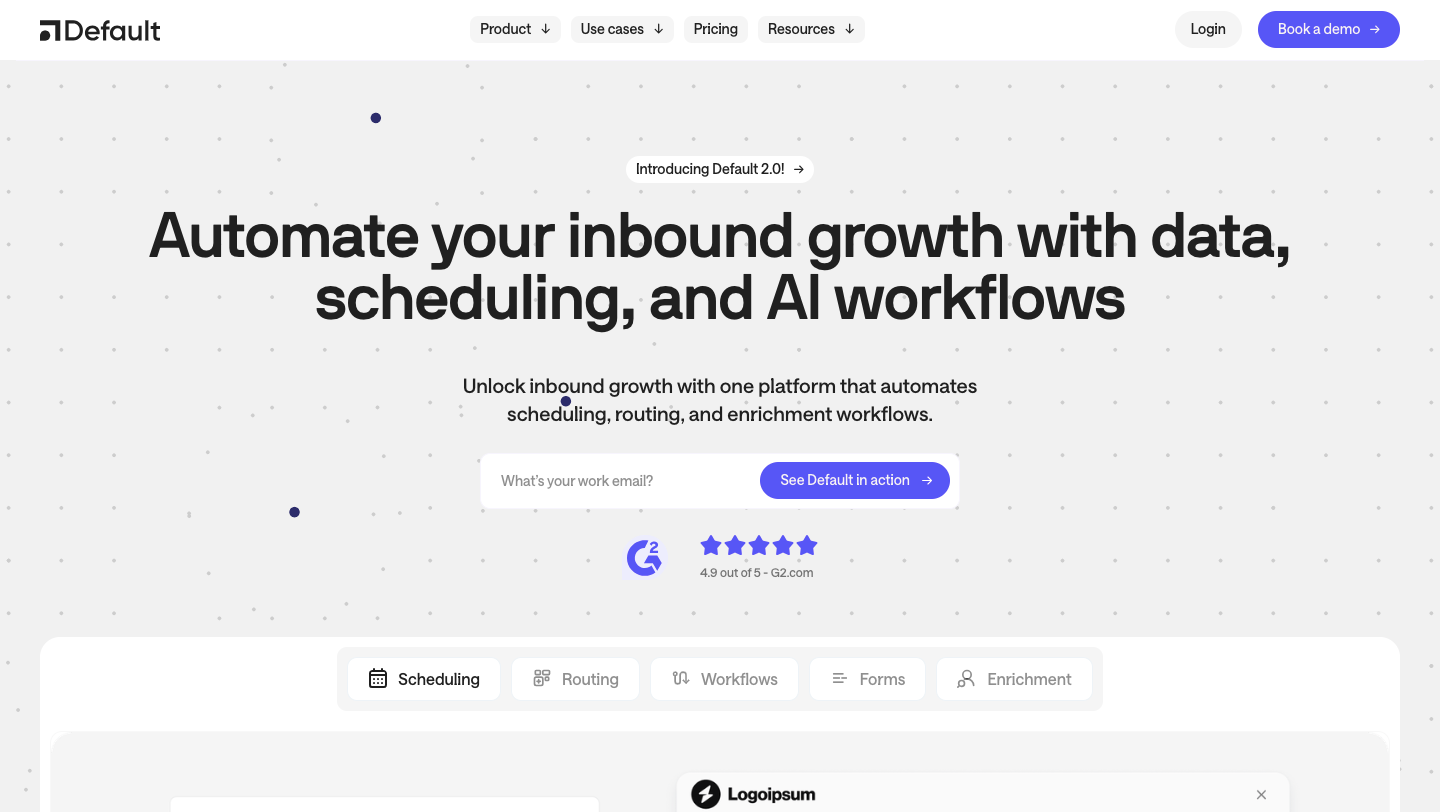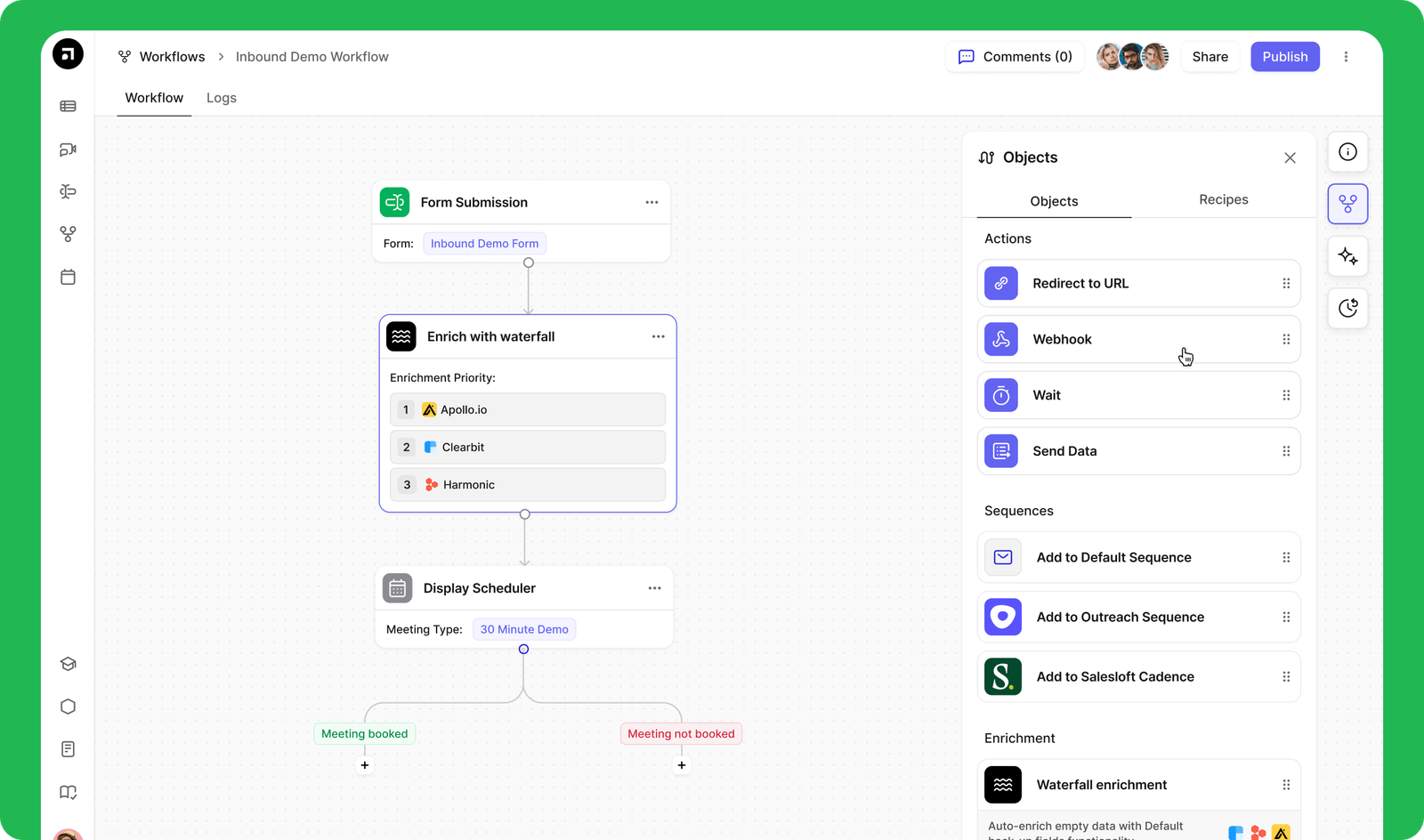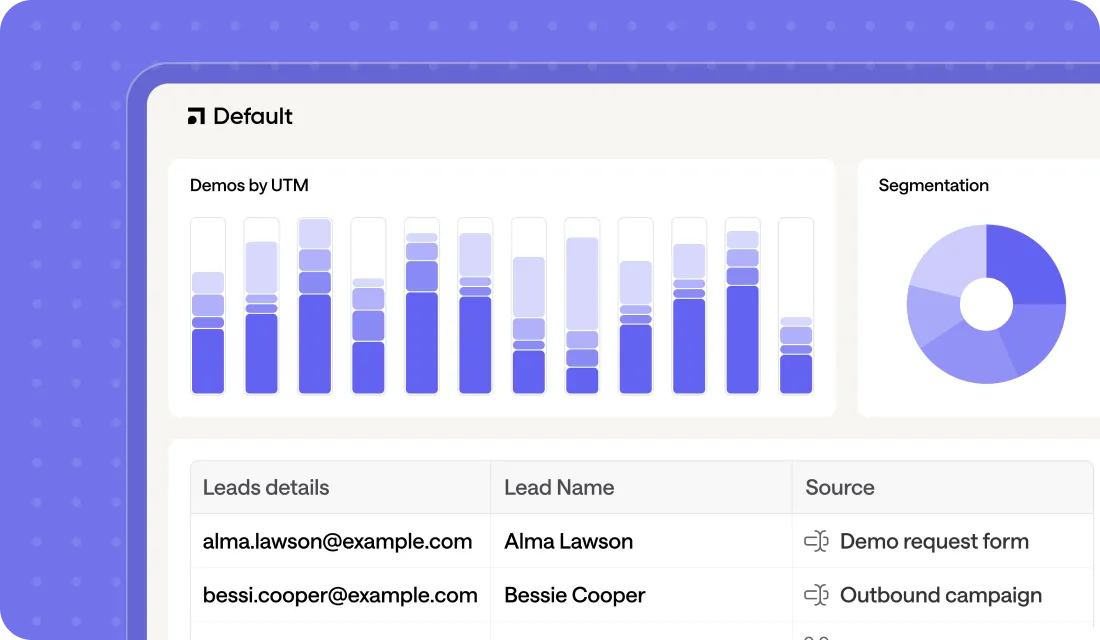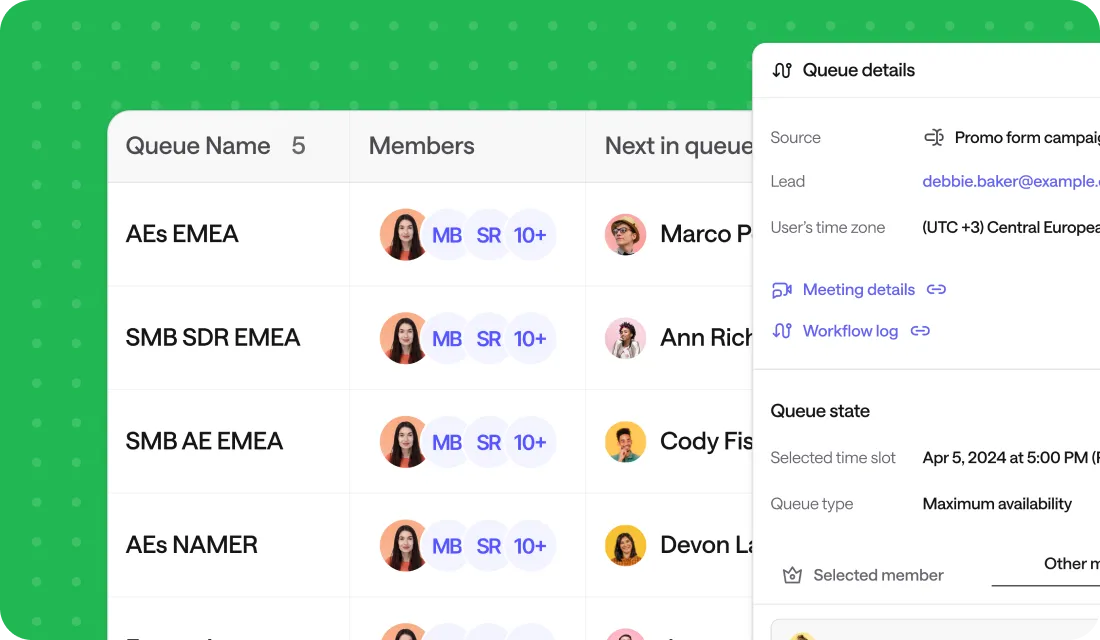Try Default

See how revenue teams automate revenue operations with Default.

Key Takeaways
Key takeaways
- Lead qualification is more than a filter—it’s a strategic control point that determines pipeline quality, forecast confidence, and sales efficiency.
- High-performing teams use structured frameworks (like BANT, CHAMP, or MEDDIC) alongside behavioral and firmographic data to assess lead readiness.
- Qualification isn’t static—it’s a live model that should evolve with your GTM motion and real conversion data.
- Tools like Default help operationalize the entire process—from scoring and enrichment to routing and feedback loops—at scale, without sacrificing precision.
According to CSO Insights, 68% of B2B organizations struggle with lead conversion due to poor qualification. Not product-market fit. Not pricing. Just letting the wrong leads through the gate.
For GTM leaders, this isn’t a sales ops footnote—it’s a systemic issue. When qualification breaks down, you don’t just lose deals. You lose forecast accuracy, rep time, marketing credibility, and pipeline confidence.
Top-performing teams solve this by treating lead qualification as infrastructure. They define fit precisely, apply frameworks consistently, and automate the handoff from interest to intent with tools like Default—so high-quality leads never get lost in the shuffle.
In this guide, we’ll cover:
- How to architect a qualification process that aligns with your GTM motion
- When to use frameworks like BANT, CHAMP, or MEDDIC—and when to evolve them
- Where automation fits, and how to scale precision without slowing reps down
Qualification isn’t just about moving faster. It’s about being right more often.
Let’s define what that means—starting with the core principles of lead qualification.
What is lead qualification?
Lead qualification is the process of assessing whether a prospect is worth moving forward—based on their fit with your ICP and their likelihood to buy. But it’s more than just a filter. It’s a control mechanism for your funnel.
Done well, qualification keeps low-fit leads out of your pipeline and high-fit ones moving fast. It aligns sales and marketing around a shared definition of “good,” and gives RevOps the levers to improve conversion rates, forecast reliability, and rep efficiency.
Whether you’re qualifying leads through manual discovery, behavioral scoring, or AI-powered workflows, the goal is the same: surface real buying intent early, and route it to the right team at the right time.
How lead qualification works
Most GTM teams have qualification steps in place. Few have a system that consistently produces high-converting leads. The difference isn’t just tooling—it’s operational clarity: Who defines fit? What counts as sales-ready? When does marketing let go?
A strong lead qualification process answers those questions with precision. Here’s what it looks like when it works:
1. Align on ICP and qualification thresholds
Before a lead enters your CRM, sales, marketing, and RevOps should be aligned on what “qualified” means—across segments and motions. That includes:
- Firmographic filters (e.g. company size, region, industry)
- Behavioral signals (e.g. demo requests, pricing page visits, intent triggers)
- Authority and timeline (e.g. buying role, implementation urgency)
2. Capture and enrich the right data
Every qualification system is only as strong as the data it's built on. Use your website forms and chatbots to collect intent signals, then enrich in real time with firmographics from tools like Clearbit or ZoomInfo.
If reps are still Googling company size before every call, your process isn’t working.
3. Apply a consistent qualification framework
Run leads through a framework like BANT, CHAMP, or ANUM (more on these later) to assess if they’re worth pursuing. Score leads based on how well they match your criteria.
4. Route immediately—based on fit and urgency
Once a lead clears the bar, routing should happen in seconds, not hours. Use your qualification logic to match leads to the right owner by territory, product line, or motion.
The goal isn’t just speed—it’s control. Manual handoffs are where hot leads go cold.
5. Analyze and refine qualification performance
Track how qualified leads actually perform. What converts quickly? What stalls post-demo? Feed this data back into your model and iterate. Qualification isn’t static—it’s a live model tied to your pipeline health.
Why lead qualification is crucial for sales & marketing
Without qualification, every lead looks the same—until they waste your team’s time or stall in the pipeline. Lead qualification eliminates that risk by ensuring resources are focused only on areas with real revenue potential.
Here’s why it matters:
Save Time and resources
Sales capacity is finite—and expensive. A structured qualification process ensures reps spend their time on leads that are actually worth it. That means fewer dead-end calls, faster time-to-close, and more room to chase high-value accounts.
Improve conversion rates
When your pipeline is full of leads who match your ICP and show clear intent, close rates rise—and sales cycles shrink. Qualification isn’t just about saying “no” to bad leads. It’s about accelerating the right ones.
Align sales and marketing
Without alignment, marketing celebrates MQL volume while sales ignores half of them. A shared qualification model tightens the handoff, improves lead follow-up speed, and makes attribution meaningful. No more finger-pointing. Just cleaner pipeline flow.
Drive predictable revenue
When your funnel is full of well-qualified leads, forecasting becomes more science than guesswork. Qualification improves stage confidence, pipeline hygiene, and your ability to plan resourcing and spend around actual deal momentum.
Most effective lead qualification frameworks
Lead qualification frameworks give structure to one of the most critical decisions in your GTM motion: Is this lead worth pursuing—right now?
The best framework for your team depends on your sales motion, deal complexity, and funnel maturity. Below are the most widely used models—and when each makes sense.
BANT (budget, authority, need, timeline)
BANT is the classic. It’s fast, simple, and efficient—best for transactional sales or high-velocity SDR motions. But it can backfire in complex deals where the budget isn’t locked down early or the champion isn’t the economic buyer.
Use it when: You need a lightweight filter for a large volume of inbound.
Watch out for: Rigidness. Disqualifying leads too early because they “don’t have budget yet” can kill long-term deals.
CHAMP (challenges, authority, money, prioritization)
CHAMP flips the script—starting with pain. It’s ideal for solution-based selling, where your product solves known business problems, and urgency comes from internal pressure, not external budget constraints.
Use it when: You’re selling a clear solution to a known challenge and need to establish priority fast.
Watch out for: Getting lost in the problem and skipping stakeholder alignment.
ANUM (authority, need, urgency, money)
ANUM leads with power. If your deals often get stuck because you're not talking to the decision-maker early, this framework helps prioritize leads with real authority.
Use it when: You’re in enterprise or multi-stakeholder environments where access matters.
Watch out for: Premature disqualification—some of your best champions might not have final sign-off, but they get you there.
FAINT (funds, authority, interest, need, timing)
FAINT is built for markets where budget isn't pre-allocated but discretionary funding exists—like early-stage or investor-backed teams.
Use it when: You're selling to startups, scaleups, or net-new categories with emerging demand.
Watch out for: False positives—interest doesn’t always equal intent.
MEDDIC (metrics, economic buyer, decision criteria, decision process, identify pain, champion)
MEDDIC is the enterprise workhorse. It’s detailed, rigorous, and excellent for high-ACV deals with long cycles and multiple stakeholders.
Use it when: You need deep qualification across multiple decision-makers, especially in complex B2B sales.
Watch out for: Overkill in high-velocity or transactional motions. If your AEs spend more time qualifying than selling, you’ve gone too far.
Types of qualified leads
Not all leads are created equal—and not all qualified leads are ready to talk to sales. Understanding the different types of lead qualification helps you map intent to action, and move buyers through the funnel more effectively.
MQL (marketing qualified lead)
An MQL is a lead that’s shown clear buying interest—such as downloading a whitepaper, attending a webinar, or repeatedly visiting key pages—but hasn’t yet engaged with sales. It signals potential, not readiness.
SQL (sales qualified lead)
An SQL is a lead that meets your defined qualification criteria (e.g., BANT/CHAMP) and is deemed ready for direct sales engagement. This is your “green light” for outreach.
PQL (product qualified lead)
Common in PLG models, a PQL is someone who has used your product and shown meaningful in-app behavior (like hitting a usage threshold). It’s driven by product data, not just marketing signals.
SAL (sales accepted lead)
An SAL is a transitional stage: a lead that sales has reviewed, accepted from marketing, and is now actively working. It’s often used to bridge the gap between MQLs and SQLs in orgs with more structured GTM motions.
IQL (information qualified lead)
Often top-of-funnel, IQLs are early-stage leads who’ve traded basic info (e.g., downloaded a resource) but haven’t shown buying intent yet. Still valuable, but not sales-ready.
Lead qualification questions to ask
Discovery isn’t just for sales. Qualification questions—whether asked by SDRs, AEs, or embedded in automation—help surface the signals that matter: intent, fit, authority, and urgency.
Below are core questions mapped to the four pillars of qualification. These can be used live in discovery, embedded in lead scoring logic, or operationalized through forms and lead routing workflows.
Fit & need: Use to validate problem-solution alignment early.
- What problem are you trying to solve?
- How are you currently handling this challenge?
- What outcomes are you looking to achieve?
- Why now?
Budget & resources: Use to qualify investment readiness and signal deal size.
- Have you allocated budget for this initiative?
- Who else is involved in budget decisions?
- Is this part of a broader strategic investment?
Authority & influence: Use to map the buying committee and reduce false positives.
- Who’s involved in the decision-making process?
- Are you the final decision maker for this solution?
- What does your internal buying process typically look like?
Timeline & urgency: Use to prioritize deals based on implementation windows.
- When are you looking to implement a solution?
- Are there any internal deadlines driving this project?
- What would happen if you didn’t solve this in the next 3–6 months?
Pro tip: Always listen for signals, not just answers. “We’re exploring options” isn’t urgency. “We’re replacing a legacy system next quarter” is.
Lead qualification checklist
Use this as a pre-handoff gate—whether manual or automated—to ensure only high-fit, high-intent leads make it to sales.
- Matches ICP criteria (industry, size, geography, role)
- Clear business need is identified
- Intent signals are present (e.g. demo request, pricing page visit, repeat engagement)
- Financial readiness is evident (budget confirmed or access to funds)
- Authority or buying path is mapped (decision-maker or internal champion)
- Timeline or urgency exists
- Scoring is complete and consistent (evaluated via your qualification model)
How to qualify sales leads
Lead qualification is part art, part ops. It’s where data meets judgment—structured through a process that minimizes false positives and accelerates real opportunities.
Here’s how high-performing teams do it:
1. Map lead data to your ICP
Before a rep touches the lead, use firmographic and behavioral filters to screen for ICP fit. Segment by industry, company size, and geography. Add behavioral layers like recent website sessions or ad engagement.
Example: A lead from a 500-person fintech company who viewed your integrations page twice this week? Keep. A 10-person agency who downloaded an eBook six months ago? Route to nurture.
2. Apply your qualification framework
Standardize evaluation with a consistent framework—BANT, CHAMP, or MEDDIC—based on your sales motion. This ensures reps qualify based on the same criteria, improving both handoffs and forecasting.
Tip: Map each framework question to a field in your CRM. If answers are missing, it’s not sales-ready.
3. Use discovery to fill in gaps
Discovery isn’t just a conversation—it’s a diagnostic. Confirm need, authority, urgency, and timing through targeted questions.
Instead of asking “Do you have budget?”, ask “What’s the process for unlocking budget for something like this?”
4. Leverage intent and engagement signals
Look at behavioral data: pricing page views, repeat sessions, product usage (for PQLs). These help you prioritize timing and tailor follow-up.
If a lead returns to your pricing page three times in two days, skip nurture—route directly.
5. Route smartly and act fast
Once a lead meets your threshold, route immediately to the right owner by territory, vertical, or product line. Use automation to reduce time-to-touch and avoid dropped handoffs.
Tools like Default can enrich, score, and route leads in seconds—not hours.
Best practices to strengthen your lead qualification process
Great qualification isn’t just about asking better questions—it’s about building a repeatable system that gets smarter over time. Here’s how to level up your process:
Use automation & AI for faster qualification
Manual triage doesn’t work when you’re handling dozens (or hundreds) of inbound leads a week. Tools like Default automate early-stage qualification using enriched firmographic data, engagement signals, and real-time behavior.
- Evaluate each lead against your ICP instantly—based on company size, industry, geography, and job title
- Score based on behavior: demo requests, pricing page views, repeat visits, or in-product milestones
- Route intelligently by region, product line, funnel stage, or rep specialization
- Auto-sync everything back to your CRM, including lead score, fit grade, and owner assignment
The result: sales touches the right leads, at the right time, with full context already in place.
2. Regularly audit your qualification model against real conversion data
What you define as a “qualified lead” should be grounded in what actually closes. Many teams rely on outdated scoring models or anecdotal feedback—leading to bloated pipelines and misaligned forecasts.
- Analyze win rates, sales cycle length, and deal size by lead source, persona, or behavior pattern
- Identify which combinations of firmographics and intent signals consistently convert—or stall
- Use that data to update your qualification thresholds, framework criteria, and lead scoring weights
Example: If leads from Series A fintech startups consistently stall post-demo, consider adjusting scoring thresholds or routing logic to reflect their lower urgency.
Align routing logic with GTM complexity—not just headcount or territory
It’s common to route based on territory or round robin—but more advanced teams route based on deal complexity, product specialization, or funnel stage.
- Early-stage or PLG leads may need onboarding specialists, not closers
- Complex enterprise leads with multiple stakeholders might go directly to senior AEs
- Mid-funnel reactivations may be better served by lifecycle marketing or CS
Default supports this level of nuance—letting you build routing flows that reflect your real GTM architecture, not just rep availability.
Create a feedback loop between sales, marketing, and RevOps
Qualification should never be a one-team decision. The most effective systems include structured feedback from reps on lead quality, regular cross-functional reviews, and shared ownership of updates.
- Run monthly or quarterly “lead quality reviews” using pipeline data and rep insights
- Track rejected or disqualified leads and look for trends in behavior, source, or segment
- Collaborate on adjustments to scoring criteria, form fields, and lead enrichment rules
This turns qualification into a shared discipline—not just a marketing gate or RevOps workflow.
Tools & software for lead qualification
The right tech stack doesn’t just speed up lead qualification—it makes it more accurate, consistent, and scalable. Here are the top tools revenue teams use to automate and optimize the process:
Default – Inbound routing & qualification engine

Default is purpose-built to operationalize lead qualification at scale. It evaluates every inbound lead against your ICP and behavioral signals, then routes it in real time—based on logic that reflects your actual GTM motion.
- Scores leads using real-time data: firmographics, engagement, product behavior
- Routes by region, funnel stage, or rep specialization—not just round robin
- Integrates directly with your CRM and MAP to maintain context across handoffs
- Removes manual triage and improves follow-up relevance at every touchpoint

Clearbit – Data enrichment & firmographic intelligence
Fills in missing firmographics, technographics, and contact data based on minimal form inputs. Ideal for improving form conversion rates and giving SDRs context from the first touch.
Limitations: Works best for US-based data; enrichment accuracy may vary for international segments or emerging industries.
Chili Piper – Meeting routing & scheduling
Automates meeting booking based on lead qualification rules. Converts qualified form fills directly into calendar invites, reducing the risk of drop-off between MQL and SQL.
Best used post-qualification—once the lead has been scored or vetted via another system.
MadKudu – Predictive lead scoring
Uses historical conversion patterns to predict lead quality. Particularly useful for SaaS companies with high inbound volume and long sales cycles.
Requires large volumes of historical data to work effectively—less useful for new segments or early-stage teams.
LeanData – Lead routing & attribution
An advanced routing and attribution engine for large-scale GTM teams. LeanData excels at complex lead-to-account matching, territory logic, and funnel attribution—especially in Salesforce-heavy environments.
Powerful but complex—implementation and management typically require dedicated RevOps resources.
Make lead qualification your competitive edge
Most teams qualify leads. Few do it well enough to drive real pipeline clarity, faster conversions, and confident forecasts.
Default helps you operationalize lead qualification—from the moment someone hits your site to the second they’re routed to sales. It scores, enriches, and routes automatically, so your reps aren’t chasing leads that were never a fit to begin with.
If you’re ready to stop guessing and start scaling with precision, see what Default can do.
Conclusion

Accelerate your growth with Default.
Revamp inbound with easier routing, actionable intent, and faster scheduling












.png)

























